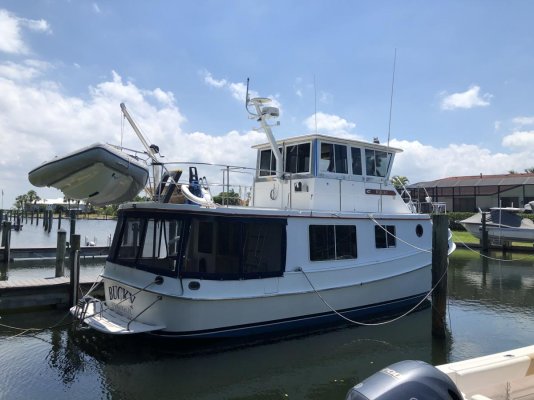Epropulsion makes 9.9 HP outboards. I was thinking a pair of those on a 40' boat might push it between 3 and 5 knots. They might also work nicely on a RIB.
If the outboards were manageable to push the boat, I would assume there should be enough diesel to run the generator without running the main engine. Obviously one would need to do some runs to determine fuel consumption over a few days.
Ted
That would be an interesting calculation. We think of generators as using very little fuel per hour. However, we don't think of that in miles per gallon and converting the generator time to the electric outboard time then to nmpg is an interesting equation.
We once did a similar calculation with ribs. Gas ribs would clearly not have the fuel capacity to serve to get one home from sea. So, the question was diesel ribs. Here was the discussion. Take a 130' boat with 5790 hp and at 11 knots it gets about 0.41 nmpg. What about the diesel RIB with 120 hp Yanmar? Let's say it can pull the larger boat at 5 knots. Now normally at 5 knots it would get much better than 0.41 nmpg. Even at 20 knots it would get over 1 nmpg. However, now it's using the hp it would at 20 to only get 5. To add to this you have the generator running to support the boat. Normally on a boat burning 40 to 200 gph depending on speed, generators burning another gallon or two is nothing. However, when you're only going 5 knots then it becomes significant to your fuel usage.
The conclusion was that the 130' boat pulled by the RIB would be less fuel efficient than under it's normal propulsion. However, it also was that the boat had a reserve of fuel at slow speeds like 11 knots and except in the greatest distances would have enough fuel to be towed by the RIB. Now this was mostly bored engineers studying and not really tested. Still seemed workable and RIB could be raised if conditions too bad. Numbers still unknown though were how fast the RIB could tow to get better fuel usage and what would happen to all the numbers based on wind and seas. What if 4'? What about 6'? Another issue was the constant refueling of the RIB. The Diesel RIB's hold 18 to 26 gallons, depending on size. If you're refueling every two hours or so, then that becomes a longer, more tedious trip home.
So where did that leave things? Certainly distance from shore would matter a lot in deciding. However, in most situations might use a RIB to make progress, but would also get another boat on the way to either repair things or to tow safely to shore even if 1000 nm. This would obviously be very expensive and would not be a traditional emergency tow service although a tow like used to move barges could be perfect or a large boat, but fuel capacity and range would be key.
Then it comes to what would disable a boat. Many things might be repaired if parts and expertise available so solution is to helicopter the parts and expert in. Then you talk about those things that couldn't be repaired at sea or where one engine wouldn't still be operable. Now you're into shafts and underwater structure and situations where you've hit something and likely have more damage and if given enough time are at risk of sinking so you must abandon the boat.
The reality is these are interesting theoretical discussions but the likelihood of the exact situation being theorized actually happening is so remote as to render the conclusions unusable. Hopefully, if presented with such an issue at sea, one can come up with a solution. The electric outboards may be possible. Factory installed get-home is the best solution if you have usable fuel and drive. Even the electric solution depends on usable diesel.
My vote is a retractable pod drive driven by the generator. It's within the hull unless needed.

